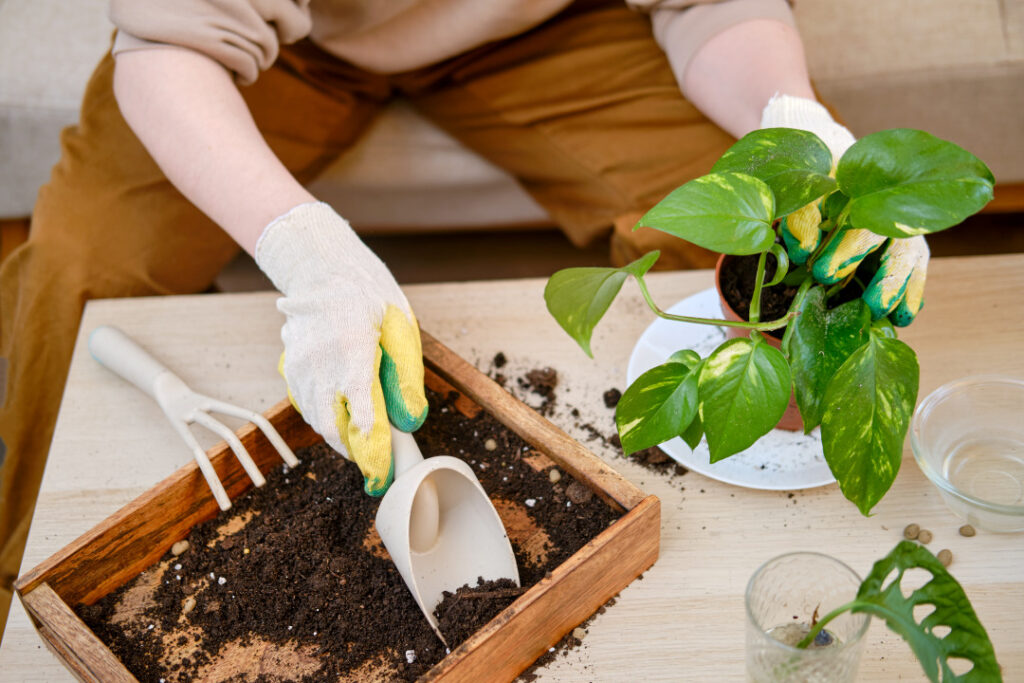
Pothos, also known as golden pothos or devil’s ivy, is a popular houseplant from the Epipremnum genus. It is a tropical vine with heart-shaped green leaves that can also come in variegated varieties featuring beautiful marbled patterns of green and yellow. Pothos plants are cherished for their lush foliage and vining nature, making them a favorite among pothos plant lovers.
Whether you are a seasoned indoor plant enthusiast or a beginner looking to add some greenery to your home, this pothos plant care guide will equip you with all the knowledge and plant care skills you need to ensure your pothos plant thrives. But before that, here are a few important pieces of information you need to know about pothos:
| Common Name | Golden Pothos, Devil’s Ivy, Devil’s Vine, Money Plant |
| Botanical Name | Epipremnum aureum |
| Family | Araceae |
| Plant Type | Vine |
| Mature Size | 20–40 feet long, 3–6 feet wide |
| Sun Exposure | Indirect sunlight, partial shade |
| Soil Type | Well-draining, moderately moist |
| Flower Color | Occasional Gold/Yellow or Purple/Lavender blooms (rare) |
| Origin | Southeastern Asia |
| Toxicity | Dogs and Cats |
| Symbolism | Good luck, Prosperity, and Happiness |
Types of Pothos
Golden Pothos (Epipremnum aureum ‘Golden’): The Golden Pothos is considered the most familiar type, with glossy, heart-shaped leaves that mix green and yellow. It’s easy to care for and can thrive in various light conditions, making it a great choice for beginners.
Marble Queen Pothos (Epipremnum aureum ‘Marble Queen’): The Marble Queen Pothos is known for its leaves, which have a striking combination of white and green colors. It’s as hardy as the Golden Pothos but prefers moderate light and may need occasional pruning to keep its appearance tidy.
Neon Pothos (Epipremnum aureum ‘Neon’): The Neon Pothos stands out with its bright neon-green leaves, adding a vibrant touch to indoor spaces. It’s easy to care for and is a good choice for those new to plant care.
Jade Pothos (Epipremnum aureum ‘Jade’): The Jade Pothos has solid dark green leaves and a more compact growth habit, making it great for hanging plants and is suitable for small spaces or hanging pots. Like other pothos varieties, jade care and growing needs are not extensive.
Pearls and Jade Pothos (Epipremnum aureum ‘Pearls and Jade’): This newer pothos feature leaves with delicate white or silvery patterns. Its unique appearance has made it increasingly popular for adding elegance to indoor spaces.
Manjula Pothos (Epipremnum aureum ‘Manjula’): The Manjula Pothos has green leaves with creamy white, silver-gray, and light green markings. It looks sophisticated and is favored by plant enthusiasts.
Cebu Blue Pothos (Epipremnum pinnatum ‘Cebu Blue’): Unlike typical pothos, this variety has blue-green leaves with a subtle silvery look. Its growth pattern provides a unique option for indoor plant collections.
N’Joy Pothos (Epipremnum aureum ‘N’Joy’): The N’Joy Pothos has green leaves with delicate white patterns, adding a touch of charm to indoor spaces. It’s easy to care for, much like other pothos varieties.
Best Time to Plant Pothos
Pothos is a low-maintenance plant that is not heavily influenced by seasonal changes. Unlike some outdoor plants that have specific planting windows tied to spring or fall, Pothos can be planted indoors year-round. Plus, it can thrive in low-light conditions. This is especially advantageous for indoor gardeners as it allows for flexibility in adding or upgrading Pothos plants whenever you desire.
However, when it comes to mature Pothos plants, you may consider repotting them if they show signs of becoming root-bound, outgrown their current pot, or the soil is depleted of nutrients. While this can be done throughout the year, spring is often considered an ideal time for repotting. This is because Pothos aligns with the beginning of the growing season and allows the plant to recover and establish itself in its new container.
Pothos Plant Care: How to Grow and Care for Pothos

Choosing the Right Environment
When caring for your pothos plant, the first step is providing the ideal environment. Pothos plants are adaptable and can tolerate various conditions, making them perfect for indoor cultivation. They can thrive in low and indirect light, although they will grow best and produce more variegation in brighter, indirect light.
It is important to remember that direct sunlight can scorch the leaves of your pothos plant, so it is best to place it away from windows with intense sunlight. Additionally, pothos plants prefer temperatures between 65-85°F (18-29°C) and thrive in environments with 40-60% humidity. If the air in your home is particularly dry, you can increase humidity around your pothos plant by placing a tray filled with water near it or using a humidifier.
Choosing the Right Pot and Soil
Choosing a pot with good drainage is essential when potting your pothos plant. Pothos plants prefer to be slightly rootbound, so selecting a pot that is just a little larger than the plant’s root ball is ideal. This will prevent overwatering and potential root rot, as excessive moisture can harm your plant’s health.
As for the potting soil, a well-draining mix is essential for the overall health of your pothos plant. You can use a commercial potting mix designed for houseplants or create your own by combining equal parts of peat moss, perlite, and vermiculite. This will provide the necessary aeration and drainage for your plant’s roots.
Mastering Proper Watering and Fertilizing Techniques
Proper watering is crucial for the care of your pothos plant. It is important to strike a balance, as overwatering can lead to root rot, while underwatering can cause stress and leaf browning. As a general rule of thumb, water your pothos plant when the top inch of the soil feels dry to the touch. Ensure excess water drains from the pot, and do not let your plant sit in standing water.
When it comes to fertilizing, pothos plants are relatively low-maintenance. During the growing season, typically from spring to fall, you can feed your pothos plant with a balanced liquid houseplant fertilizer once a month. Dilute the fertilizer to half the recommended strength and apply it to moist soil to avoid burning the roots. Fertilizing your pothos plant will promote healthy growth and vibrant foliage.
Propagation and Pruning

Pothos plants are incredibly easy to propagate, making them a favorite among plant lovers. You can propagate your pothos plant through stem cuttings, which involves cutting a stem just below a node and placing it in water or moist potting soil until it develops roots. Once roots have formed, you can transfer the cutting to a pot with well-draining soil and continue caring for it like a mature pothos plant.
Regular pruning is also important for your pothos plant’s health and appearance. Pruning helps control the size and shape of the plant, prevents legginess, and encourages bushier growth. Use sharp, clean pruning shears to remove dead or yellowing leaves and overgrown or unruly vines. You can also prune your pothos to encourage branching and create a fuller, more compact plant.
Recognizing and Treating Common Pothos Issues
While pothos plants are generally easy to care for, they can still encounter a few issues. One common problem is pale or brown leaf tips, which can be caused by lack of water, low humidity, or exposure to dry air. To prevent this, water your pothos plant regularly and provide adequate humidity.
If you notice that your pothos plant does not generate new growth or lose some leaves in their variegation, it may indicate that the plant is not receiving enough light. Consider moving your pothos to a brighter location or closer to a window with indirect sunlight.
Frequently Asked Questions
Q: What is the best way to pot a common pothos plant?
A: The best-growing tips for potting a pothos plant include choosing a well-draining potting mix and picking a container with drainage holes. Place some gravel or small rocks at the bottom of the pot for additional drainage. Gently remove the plant from its current pot and loosen the roots before placing it into the new pot. Fill the pot with the potting mix, leaving some space at the top for watering. Water the plant thoroughly after potting and place it in an area with indirect light.
Q: What makes the golden pothos variety unique?
A: The golden pothos variety, known as Epipremnum aureum, stands out for its beautiful variegated leaves. Unlike the standard green pothos, golden pothos display leaves with splashes or streaks of yellow, cream, or white. This unique foliage adds a touch of elegance and brightness to any indoor space. Golden Pothos is also known for tolerating low light conditions, making it a popular choice for indoor environments with limited natural light.
Q: How can I propagate pothos plants successfully?
A: Propagating pothos plants is relatively easy and can be done through stem cuttings or by dividing the plant. Select a healthy vine with at least two leaves to propagate through stem cuttings. Cut just below a node (the point where the leaf attaches to the stem) and place the cutting in water or a well-draining potting mix until roots develop. To propagate by division, carefully remove the plant from its pot and gently separate the root ball into multiple sections, ensuring each has roots and foliage. Pot each division into its own container and provide proper care for each new plant.
Q: What are some houseplant tips for pothos care?
A: When caring for pothos plants, providing them with the right conditions to thrive is important. Pothos care involves shedding them to bright, indirect light, but they can also tolerate low-light conditions. Keep the soil moist but not overly waterlogged, as pothos plants can be susceptible to root rot. Allow the top inch of soil to dry out before watering again. Pothos plants are relatively low maintenance but benefit from regular dusting of their leaves to keep them clean and free from dust buildup. You can also occasionally mist the leaves to increase humidity.
Q: When should I consider repotting my pothos plant?
A: Repotting your pothos plant is necessary when it becomes root-bound, meaning the roots have outgrown the current pot. You may notice roots growing through the drainage holes or coiling around the inside of the pot. Additionally, if the plant stops growing or the soil dries out quickly after watering, it may be a sign that the pot is too small. Repotting is best done in the spring when the plant is actively growing. Choose a slightly larger pot and follow the potting instructions mentioned earlier.
Q: How often should I fertilize my pothos plant, and when should fertilizer be used?
A: Pothos plants benefit from regular fertilization, typically in spring and summer, during the growing season. You can use a balanced, water-soluble fertilizer, diluted to half-strength, every two to four weeks. A general rule of thumb is to fertilize from March to September. It’s important not to over-fertilize, as this can lead to fertilizer burn and damage the plant. Always follow the instructions on the fertilizer packaging for the specific dilution ratios and application methods.
Q: What are some creative ways to display and grow pothos indoors?
A: There are several creative ways to display and grow pothos indoors. You can hang the pothos leaves or the plant itself in a decorative hanging basket or place it on a plant stand to elevate it to eye level. Pothos can be grown as a trailing plant, cascading down from shelves, mantels, or bookcases. You can also train the vines to climb a moss pole or a trellis for added vertical interest. Experiment with different containers and arrangements to create a visually appealing display that suits your style and space.
Conclusion
In conclusion, caring for a Pothos plant can be a rewarding and enjoyable experience, even for those who may not have a green thumb. By following the tips and guidelines outlined in this ultimate growing guide, you can effectively grow your Pothos like a pro and enjoy its lush beauty in your home or office.
Remember to provide your Pothos with the right amount of light, water, and well-draining soil. Regularly check for signs of pests or diseases and take prompt action if any issues arise. Pruning and propagating your Pothos can help maintain its shape and create new plants to share with friends and family.
Additionally, pothos plants are not only aesthetically pleasing but also known for their air-purifying properties, making them a valuable addition to any indoor space. With patience, care, and knowledge, you can watch your Pothos thrive and flourish, adding a touch of nature to your life while improving the air quality around you.
So, whether you’re a seasoned plant enthusiast or just starting your journey with houseplants, you now have the tools and insights to care for your Pothos with confidence. With a little love and attention, your Pothos will reward you with its vibrant green foliage and a sense of accomplishment in your gardening skills. Happy gardening!
For more lovely articles like this, subscribe to our community at the Family Hint today!




